How to Deodorize a Couch - 7 Easy Tips & Options
Author: Anne Cowart | Editor: Omar Alonso
Review & Research: Jen Worst & Chris Miller

The living room is the heart and soul of the home. We've all spent thousands of hours on the couch laughing, chatting, cheering for our team, or crying through a movie that tugged on everyone's heartstrings... without a thought of how to deodorize a couch.
Our couch carried us through those excruciatingly hot days, drenched in sweat, unable to move, and freezing cold winters, requiring cuddle puddles under blankets with a cup of hot cocoa. Our children used them to escape the dreaded floor of lava and created couch forts with their friends to pass the time during sleepovers with friends.
Much to our dismay, our fur babies marked their territory on them, some using the hard corners as chew toys. We've hosted parties on and around the couch, and the inevitable accidental spill occurs. Friends who couldn't drive home used the couch as a sanctuary to lay their weary heads.
Lately we've used our sofas to hold our internet video meetings, entertain, and homeschool our kids for long periods. Let's not forget those afternoon siestas because working from home is exhausting. There's no denying the sofa's importance and its role in our lives.
7 Ways to Clean a Couch That Smells
After reminiscing about these wonderful times on the couch, one thing comes to mind – it could use a good cleaning. Here's what you need to know about deodorizing a smelly couch. But before you ask how to clean a couch that smells, you need to check the cleaning codes on the label.
1) Check the Label
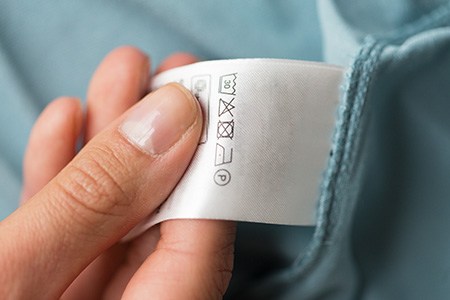
Like clothing, most couches come with labels or instructions for proper care. It's important to read the instructions to learn what cleaning materials and techniques are safe for specific types of upholstery fabric. This strategy saves you from damaging the couch. Checking the label is a must before you even ask how to deodorize a couch.
Feeling confused after seeing a few random letters on the label? The letters signify cleaning codes. Here's a breakdown to make things easier to understand.
- W: This stands for water-based cleaners. Look for water-based upholstery cleaners to use on your couch.
- S: Only use solvents for safe cleaning practices. The primary component of these cleaners is the solvent or detergent. Avoid any water-based cleaners, including steam cleaning.
- S/W: This acronym means you can use both solvents and water-based cleaners to freshen up your couch
- X: Avoid using any cleaners. The best choice is a vacuum to clean your couch.
If you're still looking for the label or trying to figure out the best way to clean your couch, contact the manufacturer, or check online. It's a good idea to double-check the manufacturer's label for your cushions and the cover; they may have different instructions for cleaning.
2) Clean Up Spills & Stains Immediately
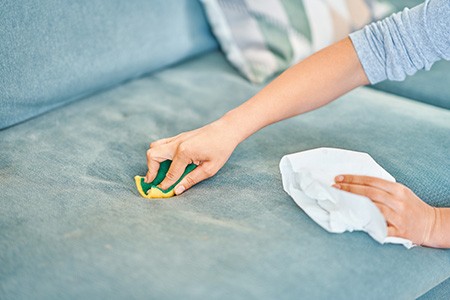
Ensure you promptly clean up any spills on the couch upholstery. Leaving food in the folds of the couch will cause it to develop a rotten odor. The sooner and the more of a spill you get out, the less of a chance you'll be on the internet asking how to deodorize a couch again in the future.
While you think it would be okay to let water spills air dry, it can create a moldy smell in the fabric. Use a clean towel to soak as much liquid from the couch as possible in the event of a water spill.
Stains become tougher to remove the longer you leave them on the couch. Cushions are an important part of the couch. Remember to double-check the label. If your cushion covers unzip, place a towel between them. This strategy prevents the stain or cleaning solution from permanently damaging the cushion.
Some people snuggle their cushions to feel emotional comfort, some use them to hide insecurities, while others use them to catch forty winks, most likely drooling over them. If they're machine washable, use a delicate cycle.
If they're not machine washable, place them in a plastic bag. Use a vacuum cleaner to suck the air out of the bag. This strategy helps relieve the scent of lingering smells.
3) Use a Dry Brush & Vacuum
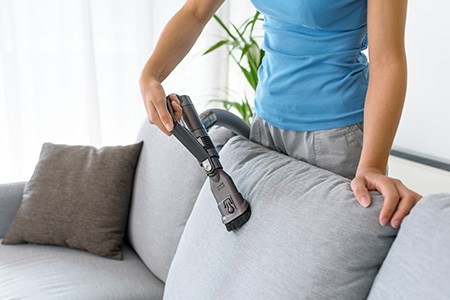
Vacuuming your couch should be a regular occurrence to keep it clean and smelling great. Vacuuming won't necessarily eliminate funky smells, but it's a good first step in eradicating dander, hair, and dust.
Vacuums are gentle enough to use on leather, fabric, and microfiber couch covers. Handheld types of vacuums make this incredibly convenient and fast, too. While this isn't a direct method regarding how to deodorize a couch, it's a preliminary step and a preventative measure.
Vacuums and brushes are the safest and easiest ways to clean your couch, and brushes on vacuums are even better. They're ideal for removing crumbs, dust, and other dry debris. A natural dry bristle brush does the trick to loosen dust and dirt. Get in all the crevices and sneaky corners when vacuuming.
4) Homemade Cleaning Solutions
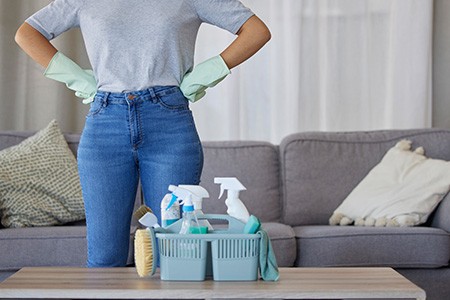
Baking soda is your best friend when cleaning most types of couches. It's an unbelievable cleaning agent for deodorizing a pungent couch. This enzyme-based cleaner has a two-part action, removing odors and stains from the upholstery. Baking soda is good for cleaning both fabric and leather sofas. Using baking soda as a deodorizer is easy and effective; try this method.
Sprinkle it on your sofa and work it into the material. Wait a day or two for it to absorb the odors, then use a vacuum to pull up the baking soda. If you need to use the couch in the evening, apply the baking soda in the morning while the kids are at school and you're at work.
The baking soda absorbs odors from the sofa. Once you've vacuumed it up, you should expect a big reduction in odors. It's worth pointing out many professional cleanup crews use baking soda for deodorization and sprinkle the baking soda liberally over the upholstery for the best results.
Use equal parts baking soda and water to penetrate deep into stains, but avoid this method for leather couches (don't use mineral oil on leather either). Let it sit for 10 to 20 minutes to pull up the stain. Then, vacuum the baking soda or wipe it off with a damp cloth. This works magic for how to deodorize a couch.
This strategy is good for pet owners and parents with small children who need to clean up urine stains from the couch. Baking soda absorbs it, preventing lingering urine odors. Provided your couch is labeled "S/W" or "W," make a homemade cleaning solution by combining two parts water with one-part vinegar and a few drops of standard dish soap.
Dab or spray the mixture on the stain and gently blot it with a clean cloth. If unsure, test a small area to ensure your couch doesn't discolor. You can deodorize furniture like this of all types, too.
5) Steam Cleaning
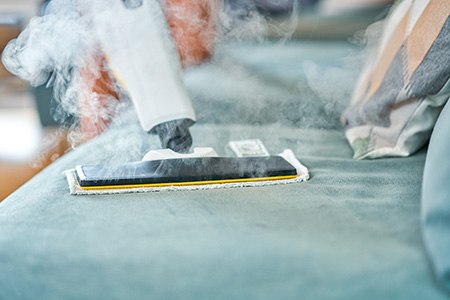
Steam cleaning is an effective method for water-approved couches, killing most species of bacteria. Remember to check if your sofa can withstand the heat the steam cleaner produces. You'll need to rent an upholstery steam cleaner.
These appliances come with detailed instructions on how to use them, and it's not rocket science. Test it on a small hidden spot on the couch. Start by vacuuming the sofa on a summer's day while the windows are open. Commence the steam cleaning process and let your couch dry completely.
6) Fabric Refresher Sprays
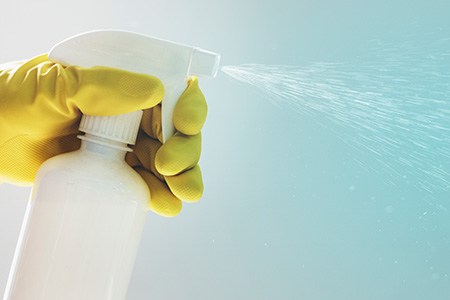
An odor-eliminating spray is a good alternative to baking soda when it comes to how to deodorize a couch, because there's no clean-up afterwards. Fabric couches trap cooking odors, body oils, fur, dust, and more.
There are plenty of options for deodorizing sprays, with a top choice being Lysol, the all-around smell exterminator. Ozium is another must-have deodorizer, and a good choice for smokers to eliminate stale tobacco smells from the upholstery.
A little goes a long way with Ozium, and Febreze is another good option. There's a reason Febreze stood the test of time in household cleaning applications; it's scientifically proven to eliminate odors. The molecules in Febreze entrap scent molecules, leaving the couch smelling fresh.
White vinegar is another great home-based option for deodorizing your couch, and it's cost-effective. White vinegar features antibacterial properties, eliminating the microorganisms that cause odors. Use white spirit vinegar, not white wine vinegar. Add it to a spray bottle and mist your couch.
As the vinegar dries, it dissolves the smell. On a side note, stand about a foot away and go easy on the spray; aim for a light misting, not total saturation. Vodka is another effective couch cleaner to eliminate bad smells. Use the cheap stuff and decant it into a plastic spray bottle. Spray lightly on your couch to eliminate haunting odors. That's a fun method for how to deodorize a sofa, if you catch my drift.
7) Activated Charcoal, Coffee Grounds, & Dryer Sheets
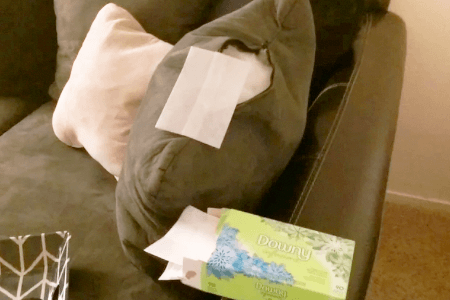
Place a tray filled with a cup of activated charcoal on the couch for several hours. This material absorbs chemicals and odors. It's a great couch deodorizer and a wonderful natural air purifier for the room.
Don't sprinkle coffee grounds directly on your sofa. It's a sofa deodorizer but can cause stains and discoloring. Coffee grounds contain high nitrogen levels, which is a great odor absorber. The best strategy is to fill a small jar with unused coffee grounds and place it next to your couch. Note that this will also deodorize the entire room.
Dryer sheets are ideal for absorbing moisture from the sofa and neutralizing musty odors. Place some dryer sheets directly on the spill. Use as many as may be needed, depending on their size. Some people will rub their couch fabric down with dryer sheets or even stuff them into the pillows, if they can open them with a zipper.
That’s How to Get Odor Out of a Couch
There's no shame in admitting defeat. If the smell you are trying to eliminate is still hanging around, it might be time to call the professionals who know how to deodorize a couch perfectly. These services help with extending your couch's service life. So, it may be worth treating your sofa to a spa day every now and again. Give it the attention it deserves, and it will last for years.




